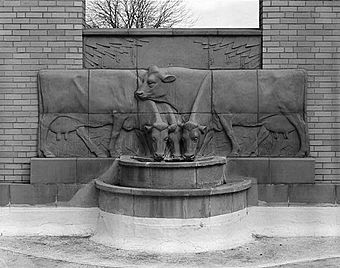Food Sciences Building facts for kids
Quick facts for kids |
|
|
Christian Petersen Courtyard Sculptures, and Dairy Industry Building
|
|

One of Christian Petersen's sculptures.
|
|
| Location | Wallace Rd., between Beach and Union Dr. on the Iowa State University campus, Ames, Iowa |
|---|---|
| Area | less than one acre |
| Built | 1927-1928 |
| Built by | J. and W. A. Elliott Construction |
| Architect | Christian Petersen Proudfoot, Rawson & Souers |
| NRHP reference No. | 87000020 |
| Added to NRHP | April 7, 1987 |
The Food Sciences Building at Iowa State University in Ames, Iowa is a special place. It used to be called the Dairy Industry Building. This two-story building was finished in 1928. It's made from a type of stone called Bedford stone.
What makes this building truly unique are the amazing sculptures found inside and in its courtyard. These artworks were added to the National Register of Historic Places in 1987, along with the building itself.
Contents
The Food Sciences Building and Its Art
While the building is old, the art inside is even more famous. These sculptures were created during the Great Depression. This was a time in the 1930s when many people struggled to find jobs. The government started special projects to help artists.
Meet Christian Petersen, the Artist
The artist who made these sculptures was Christian Petersen. He was an immigrant from Denmark. Petersen created nine special artworks called bas reliefs. A bas relief is a type of sculpture where the figures stick out from a flat background. Think of it like a 3D picture carved into a wall.
He made these sculptures between 1934 and 1935. This was part of a government program called the Public Works of Art Project (PWPA).
Inside the Building: Plaster Panels
You can find two of Petersen's bas reliefs in the building's main entrance, called the foyer. These two panels are made of plaster.
One sculpture shows a woman from ancient times. She is churning butter in a bag made from goatskin. The bag hangs from a tree. The other sculpture shows an American pioneer woman. She is using an early American invention called a dash churn to make butter. These two panels were finished in 1934.
The Courtyard's Terra Cotta Art
The other seven bas reliefs are in the building's courtyard. These were designed in a workshop in Iowa City, Iowa. They are made from a special material called terra cotta. Terra cotta is a type of reddish-brown baked clay. Using terra cotta for sculptures was not very common by the 1930s.
The central sculpture in the courtyard is above a fountain. It shows three Jersey cows and a bull. Water flows from the fountain into a pool below.
The panels on the left side of the courtyard show how dairy farming used to be. They show scenes like milking cows by hand. They also show milk being taken to market by wagon. Other scenes include separating milk and churning butter.
The panels on the right side show how dairy farming had become more modern by 1934. These sculptures show machines for milking cows. They also show equipment for testing milk and separating cream. You can also see machines for pasteurizing milk, cooling it, and making cheese.
A professor named Martin Mortensen, who led the Dairy Industry department, helped Petersen make sure the dairy technology in the sculptures was correct. Another professor, Maurice Hanson, designed the courtyard's walkways and plants.
Art from a Special Project
The Public Works of Art Project (PWPA) in Iowa was led by a famous painter named Grant Wood. He was known for his "regionalist" art, which focused on scenes from the American Midwest.
Christian Petersen was the only sculptor in Iowa's PWPA program. He later became the official sculptor for Iowa State University. Most of his art can be found in Iowa.
These sculptures are special because they are rare examples of government-funded art on a college campus in the Midwest. Most PWPA sculptures were placed in big cities on the East and West coasts.



